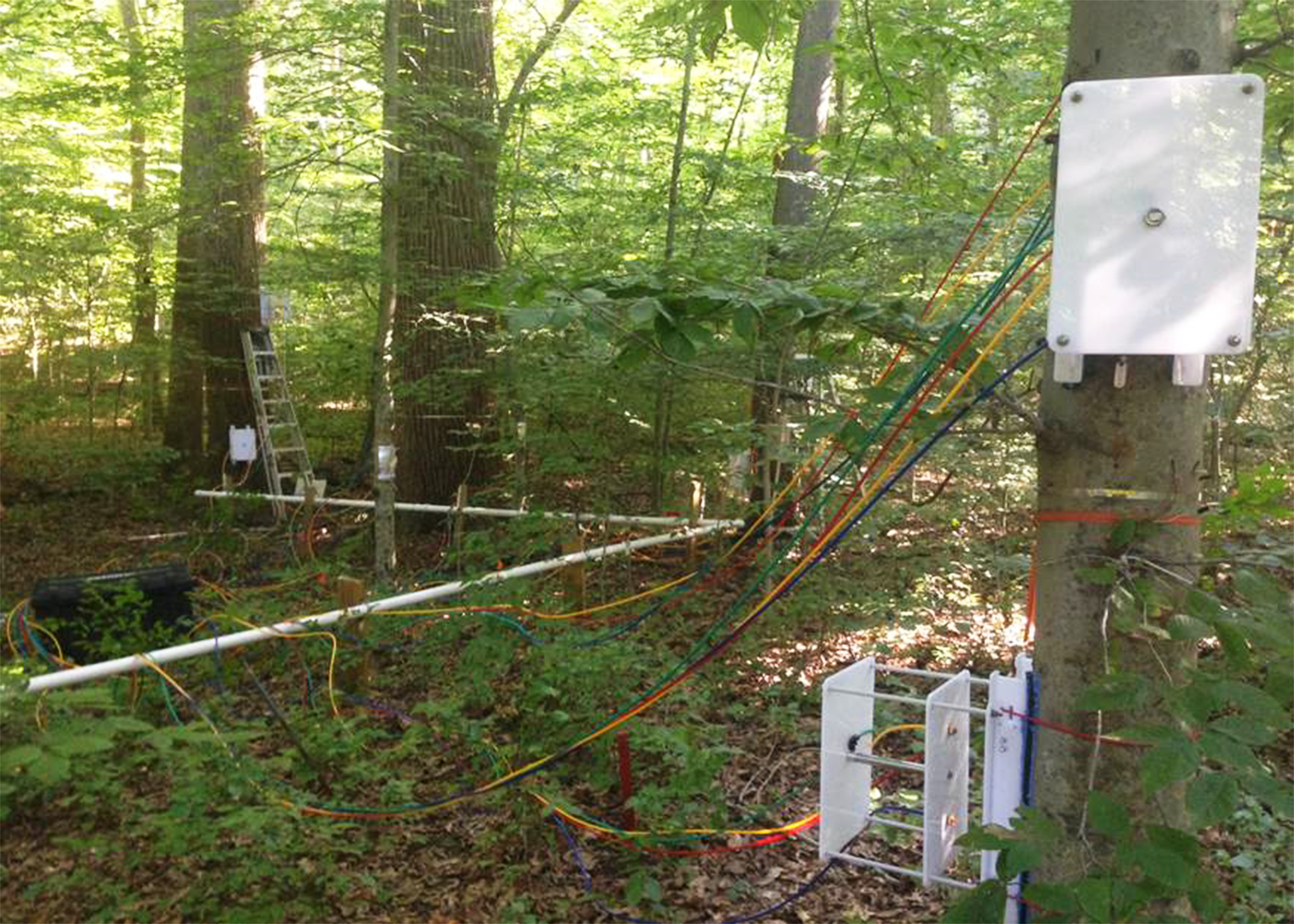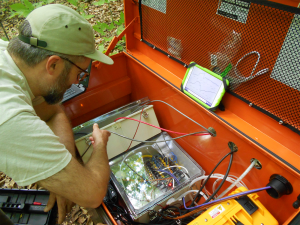by Ryan Greene

Methane flux chambers keep track of how much methane a tree trunk releases or consumes. Credit: Pat Megonigal/SERC
Rainbow-colored tubes snake through the undergrowth. White acrylic chambers sit mounted to tree trunks like giant bleached snails. At first glance, it’s not quite clear what the heck is going on. Cryptic as it may seem, these tubes and chambers are the key to a recent study showing that trees in upland forests are capable of emitting the planet-warming greenhouse gas, methane.
Scientists have long considered upland forests to be methane sinks due to the presence of methane-hungry microbes called methanotrophs in their soils. But new research by Pat Megonigal, an ecosystem ecologist who heads up the Biogeochemistry Lab at the Smithsonian Environmental Research Center (SERC), and Scott Pitz, a graduate student from Johns Hopkins, has shown that when it comes to upland forest methane cycling, soil isn’t the only game in town. Trees and their emissions are part of the equation too.
In a recently published study in New Phytologist, Megonigal and Pitz found that trees in upland forests are actually capable of emitting methane through their trunks. This means that some of the methane absorbed by methanotrophs in the forest soils may be offset by tree emissions.
Why, though, does any of this even matter?
When researchers think about global climate change, they need to think about heat-trapping greenhouse gases like carbon dioxide (CO2) and methane (CH4). Specifically, they’ve got to track these gases to see where they’re coming from (their sources) and where they’re getting stored (their sinks). Carbon dioxide receives much of the spotlight (and rightfully so, given its enormous impact on the global climate), but it’s also critical to keep an eye on methane. Although methane stays in the atmosphere for far less time than carbon dioxide, it’s capable of trapping up to 45 times more heat. In other words, methane is a big deal. If temperate forests are consuming less of it than we thought, as Megonigal and Pitz’s research suggests, that could be a big deal too.
AN EYE ON THE FLUX
Since methane is invisible to the human eye, scientists can’t just watch to see how it’s moving through the environment. That’s why Megonigal, Pitz and SERC intern Andrew Sample outfitted their experimental trees with static-flux chambers. These chambers allowed them to “see” whether methane was moving into or out of the trees’ trunks. While most of the trees had chambers that took measurements monthly, a couple trees sported high-frequency flux chambers that took measurements every forty five minutes. This let the researchers watch how methane levels changed over the growing season and over the course of the day. Getting these measurements took ingenuity and inventiveness.
“The system Scott Pitz designed and built is totally unique—it’s never been done before,” Megonigal said.
MYSTERY METHANE
Thanks to their flux chambers, Megonigal and Pitz were able to show that upland forest trees are, in fact, capable of emitting methane. Not only did these emissions reduce the degree to which the forest was acting as a methane sink (1 to 6 percent less, on average), but in some cases they even seemed to switch the forest into a net methane source. This, to say the least, is surprising given methane’s potential to dramatically impact the climate.
All of that said, it’s also important to remember that this study didn’t look at the whole tree—it only evaluated the methane emissions from the trunk. According to Megonigal, it’s possible that methane might be consumed up in the canopy, and that could “make these systems bigger methane sinks than we think they are.”
Nevertheless, it’s indisputable that the trunks are releasing methane. One big question remains, though—where in the world is all this methane coming from?

SERC postdoc Paul Brewer shows off the equipment he’s using to monitor trees’ daily patterns of methane release. Tubes carry air from the flux chambers into this central container for analysis. Credit: Ryan Greene/SERC
Megonigal guesses that it’s likely from microbial activity within the tree or from groundwater drawn up by the roots. Either way, he says it’s probably not one or the other, but some combination of both. To get to the bottom of this methane mystery, Paul Brewer, a postdoctoral fellow in the Biogeochemistry Lab, is now redeploying the monitoring system developed by Pitz and Sample.
“This high-frequency method is one way we think that we might be able to uncouple the two [i.e. microbes and groundwater] and figure out what the actual source of the methane is in any given situation,” Megonigal says.
THE WAY FORWARD
This isn’t the first time scientists have caught upland forests letting some of their methane escape. Over the past year or so, a number of other studies have reported this phenomenon in a variety of forests on three separate continents. Megonigal co-authored the first of these studies with Zhi-Ping Wang of the Chinese Academy of Sciences in February 2016.
But it’s one thing to document a phenomenon, and another thing entirely to understand it. What makes Megonigal and Pitz’s paper so crucial is that it not only catalogues upland forest tree emissions, but also sketches a path forward for tracking these emissions back to their source. Snaking tubes and snail-like chambers might just be the type of “eyes” we need to “see” what’s really going on.
Citation: Pitz, S. and Megonigal, J. P. (2017), Temperate forest methane sink diminished by tree emissions. New Phytol. doi:10.1111/nph.14559
Link to article: http://dx.doi.org/doi:10.1111/nph.14559

